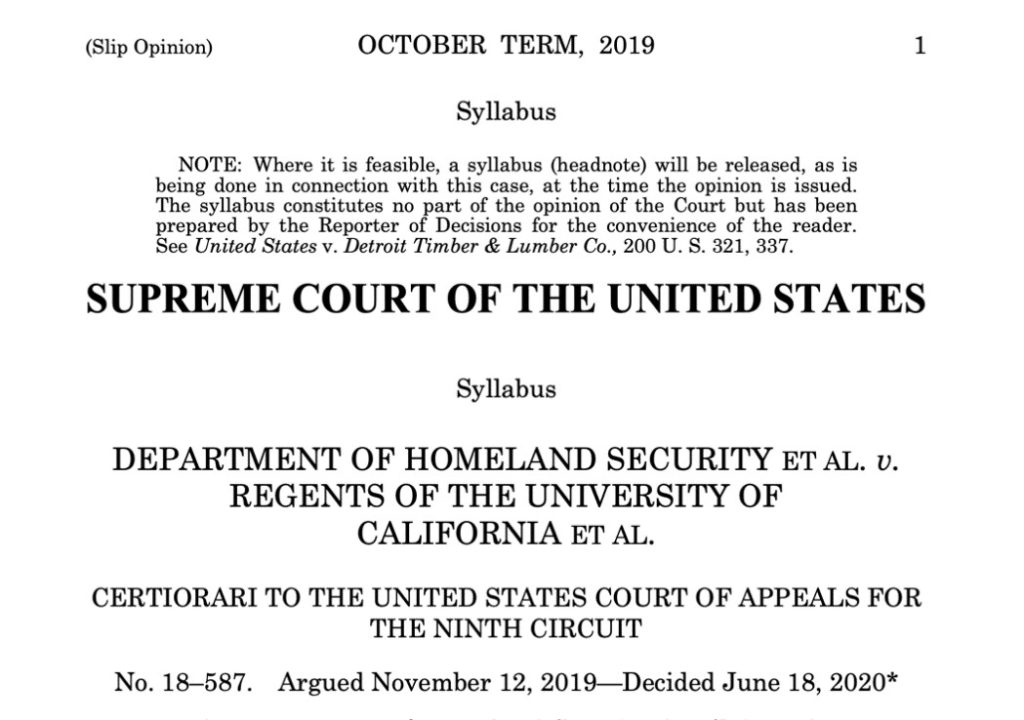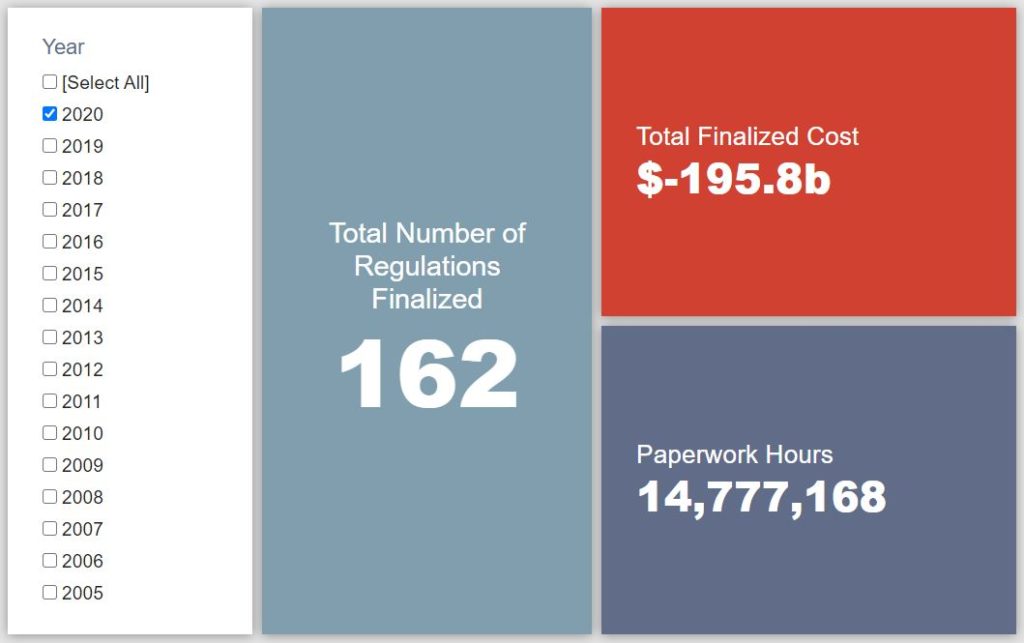Week in Regulation
June 22, 2020
Supreme Court Rulings Highlight the Week
Last week there were nine rulemakings with some quantified economic estimate; all but one had less than $6 million in economic impact. Meanwhile, the major news of the week came from a pair of significant Supreme Court decisions. One – as detailed in this week’s regulatory picture below – demonstrated the importance of administrative procedure. The other set a historic precedent regarding nondiscrimination law that may, albeit somewhat tangentially, have implications for the week’s most notable rulemaking. Across all rulemakings, agencies published $3.4 billion in total net cost savings but added 1.3 million hours of annual paperwork.
REGULATORY TOPLINES
- Proposed Rules: 24
- Final Rules: 55
- 2020 Total Pages: 37,279
- 2020 Final Rule Costs: -$195.8 billion
- 2020 Proposed Rule Costs: $7 billion
TRACKING THE REGULATORY BUDGET
The only rulemaking that moved the needle on the fiscal year (FY) 2020 regulatory budget was a final rule from the Department of Health & Human Services (HHS) regarding “Nondiscrimination in Health and Health Education Programs or Activities, Delegation of Authority.” For the purposes of the regulatory budget, HHS estimates the rule could bring $240 million in annualized savings, or roughly $3.4 billion in present value. The agency notes that “the largest proportion of these estimated savings would result from repealing the 2016 Rule’s provisions related to mandatory notices.”
As we noted, however, in our review of the rule’s proposed version: “Among the core substantive issues at hand is how the agency interprets discrimination ‘on the basis of sex.’” It so happens that last week also saw the Supreme Court decide that the protections afforded to an individual by Title VII of the Civil Rights Act of 1964 on the basis of sex extend to one’s sexual orientation and gender identity. While this ruling does not directly impact the implementation of this current rule (entirely different statutes involved), it will almost certainly be a major component of any subsequent litigation on the matter.
The Trump Administration expected to reach $51.6 billion in cumulative net savings in FY 2020. To date in the fiscal year, agencies have officially published 95 deregulatory actions and 31 regulatory actions, totaling $198 billion in quantified total net cost savings.
THIS WEEK’S REGULATORY PICTURE
This week, the U.S. Supreme Court finds the Trump Administration’s attempt to end an Obama-era immigration policy runs afoul of the Administrative Procedure Act (APA).

Source: https://www.supremecourt.gov/opinions/19pdf/18-587_5ifl.pdf
On June 18, the Supreme Court ruled that the 2017 decision by the Department of Homeland Security (DHS) to terminate the Deferred Action for Childhood Arrivals (DACA) policy ran afoul of the APA. Specifically, the Court determined, by a 5-4 vote, that DHS’s decision to terminate was arbitrary and capricious. The decision does not mean DHS cannot end the policy, but rather it needs to make the decision anew do more work to justify its action, including considering how terminating the policy would affect those that benefit from it.
Under the APA, agency decisions can be held unlawful by a federal court if an action is “arbitrary, capricious, an abuse of discretion, or other not in accordance with law.” Though many legal challenges to federal regulations argue that an agency has violated this clause, it is relatively rare that actions are struck down because of it.
What made the DACA termination arbitrary and capricious, according the Court, was the manner in which DHS ended it. The Obama Administration DHS created the policy with a memorandum, so the Trump Administration DHS figured that a memorandum would suffice, and cited the fact Attorney General Jeff Sessions formally advised then-acting DHS Secretary Elaine Duke that DACA should be rescinded due to legal flaws.
The Court ruled that though DHS could terminate the policy, it needed to provide more justification than the memorandum provided. Though DHS offered additional justification to the same decision nine months later, the APA requires the Court to consider the justification made at the time of the decision. The Court found it problematic that DHS was quick to overturn the policy without considering the implications of removing its protections from those that were covered by DACA. The Court believed DHS should have considered options other than termination, even if at the end of that deliberative process it arrived at the conclusion that the policy should be terminated.
Due to the unique nature of the action in the scope of agency decisions that fall under the APA, the ruling is fairly narrow. In dissenting, however, Justice Clarence Thomas speculated that the holding could create perverse incentive for outgoing administrations.
“Under the auspices of today’s decision, administrations can bind their successors by unlawfully adopting significant legal changes through Executive Branch agency memoranda. Even if the agency lacked authority to effectuate the changes, the changes cannot be undone by the same agency in a successor administration unless the successor provides sufficient policy justifications to the satisfaction of this Court. In other words, the majority erroneously holds that the agency is not only permitted, but required, to continue administering unlawful programs that it inherited from a previous administration.”
Justice Thomas raises an interesting question that could have implications for future administrative actions, though only time will tell the true impact of the DACA decision on agencies.
TOTAL BURDENS
Since January 1, the federal government has published $188.8 billion in total net cost savings (with $195.8 billion from finalized rules) and 32.3 million hours of net annual paperwork burden increases (with 14.8 million hours due to final rules). Click here for the latest Reg Rodeo findings.












